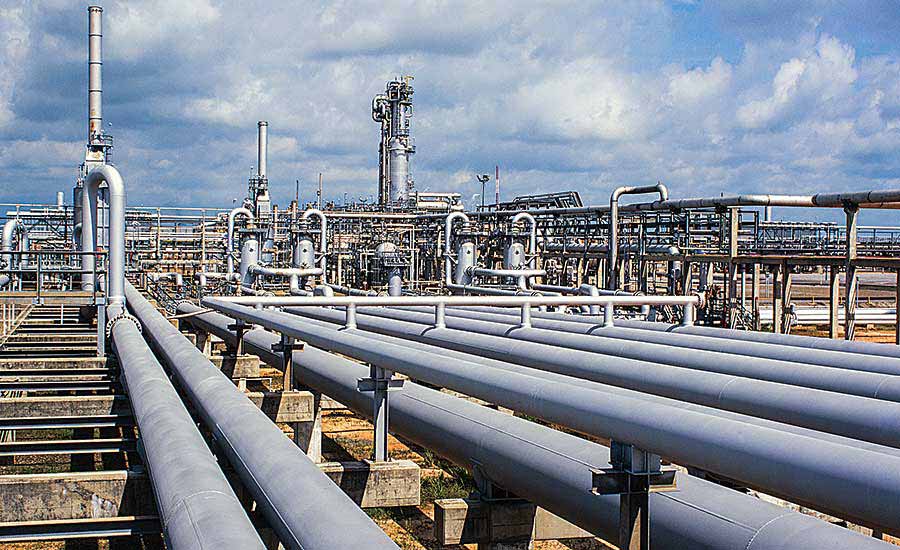With the global shipyard business experiencing a multiyear drought, ship owners and builders alike are putting their hopes on an anticipated surge in future substantial natural-gas shipment expansion.
With shipbuilders cutting more than 20,000 jobs in the last year alone, future natural gas plus West Texas Intermediate oil shipments are indicating a turnaround in 2018 and thereafter. Contracts for vessels to transport liquified natural gas are picking up amid an absence of shale gas in the U.S. Also, increasingly stringent global curbs on pollution are pushing utilities and transportation operators even harder toward clean-burning fuel, wherever it is located.
Liquid natural gas is made by cooling natural gas until it becomes a liquid. This can be carried over long distances in specially built ships with insulated tanks. Annual global LNG production capacity is expected to increase 39% to 377 million tons by 2019, from 272 million tons last year. According to Royal Dutch Shell PLC estimates, shipments of LNG could rise as much as 5% a year from 2015 to 2030.
To move such mountains of fuel will necessitate 180 more vessels. According to experts, this would benefit shipbuilders with LNG expertise. This means that segment will benefit substantially from orders to be expected as early as the middle of this year’s third quarter.
Asia is the largest destination for LNG, with much of it bound for China and India. According to Shell’s LNG outlook, China’s gas demand is expected to more than double to 450 billion cubic meters by 2030. Earlier this year, China said it plans to halt, delay or eliminate 50 gigawatts of coal-fired powered projects as part of its move to clean the smog-choking cities from Beijing to Xi’an.
The world’s three biggest shipyards, all based in South Korea, control as much as 80% of the LNG tanker market. But the entire industry will benefit substantially from this growing demand of natural gas. This couldn’t come at a more propitious time for South Korean shipyards that have had to cut back production and slash employment. In a sense, the upcoming wave of incoming orders — expected soon — could be lifesavers for some of the most concentrated shipyards in the world.
To them, the anticipated tidal wave of orders is coming at a time when access to staying in business and maintaining access to debt coverage will depend on such orders manifesting before the end of the year.
Oil and gas expansion
While energy in general, but oil specifically, has caught the attention of derivative users and investors alike since the big price break in mid-2014, it helps to know this continuously expanding energy sector comprises three major elements:
1) Upstream. Major companies, such as Exxon Mobil, Chevron and Conoco Phillips dominate exploration and production, including natural gas, which no longer is flared off, as its global usage has multiplied in recent years.
2) Midstream business covers the transport of oil and gas, primarily though pipelines from the production site to processing plants, storage facilities and end-user locations. An increasing number of these companies have structured themselves as master limited partnerships (MLPs), which have the benefit of tax-advantaged income.
3) Downstream usually refers to refining where conversion to finished product occurs. Interestingly, falling oil prices are bad for upstream, but good for refining margins. A good example is Valero (NYSE: VLO), which benefitted in 2014 as oil prices collapsed, but refineries had to pay more as per-barrel oil prices went up in the last year.
The industry’s corporate leadership is headed by the two major U.S. companies that encompass all the segments, including upstream, midstream and downstream. While similar, in the fact the “biggies” cover all aspects of energy development, the difference is their area of focus.
When focusing on Texas’ huge Permian Basin, Diamondback Energy (Nasdaq: FANG) derived 89% of its 2016 revenues from crude oil sales. In contrast, Rice Energy (NYSE: RICE), primarily active in the Appalachian Basin, generated practically all its 2016 revenues from natural gas.
But in looking at the immediate future of oil and gas, and its impact on U.S. revenue growth, the lifting of the 1974 oil embargo has opened up substantial export shipments of light West Texas Intermediate from the U.S., primarily to Asian refineries. These prefer the more limited conversion costs necessary rather than Brent crude, primarily emanating from the huge production capabilities of the Mideast, the North Sea and Venezuela.
The overall outlook for extensive expansion of oil and natural gas has been exceptionally embraced by the Trump administration, which has downplayed obsessive climate control legislation and indicated vastly increased support to fossil fuels (coal, oil and natural gas) with lesser advantages to renewables.
In looking forward to 2018 and beyond, the primary energy sector as a whole, especially natural gas, appears as safe production targets for years to come.





